Glucobrassicin Metabolites Ameliorate the Development of Portal Hypertension and Cirrhosis in Bile Duct-Ligated Rats
- PMID: 31454890
- PMCID: PMC6747388
- DOI: 10.3390/ijms20174161
Glucobrassicin Metabolites Ameliorate the Development of Portal Hypertension and Cirrhosis in Bile Duct-Ligated Rats
Abstract
Patients suffering from liver cirrhosis are often complicated with the formation of portosystemic collateral vessels, which is associated with the progression of a splanchnic hyperdynamic circulatory state. Alleviating pathological angiogenesis has thus been proposed to be a feasible treatment strategy. Indole-3-carbinol (C9H9NO, I3C) and 3,3'-diindolymethane (DIM), formed by the breakdown of glucosinolate glucobrassicin, are prevalent in cruciferous vegetables and have anti-angiogenesis properties. We aimed to evaluate their influences on portal hypertension, the severity of mesenteric angiogenesis, and portosystemic collaterals in cirrhosis. Sprague-Dawley rats with common bile duct ligation (CBDL)-induced liver cirrhosis or sham operation (surgical control) were randomly allocated to receive I3C (20 mg/kg/3 day), DIM (5 mg/kg/day) or vehicle for 28 days. The systemic and portal hemodynamics, severity of portosystemic shunting, mesenteric angiogenesis, and mesenteric proangiogenic factors protein expressions were evaluated. Compared to vehicle, both DIM and I3C significantly reduced portal pressure, ameliorated liver fibrosis, and down-regulated mesenteric protein expressions of vascular endothelial growth factor and phosphorylated Akt. DIM significantly down-regulated pErk, and I3C down-regulated NFκB, pIκBα protein expressions, and reduced portosystemic shunting degree. The cruciferous vegetable byproducts I3C and DIM not only exerted a portal hypotensive effect but also ameliorated abnormal angiogenesis and portosystemic collaterals in cirrhotic rats.
Keywords: 3,3′-diindolymethane (DIM); angiogenesis; indole-3-carbinol (I3C); liver cirrhosis; portosystemic collaterals.
Conflict of interest statement
The authors declare no conflict of interest.
Figures
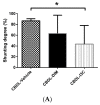

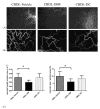
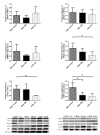
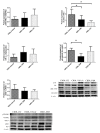


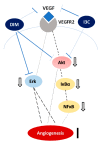
Similar articles
-
The beneficial effects of curcumin in cirrhotic rats with portal hypertension.Biosci Rep. 2017 Dec 15;37(6):BSR20171015. doi: 10.1042/BSR20171015. Print 2017 Dec 22. Biosci Rep. 2017. PMID: 29162665 Free PMC article.
-
Caffeine ameliorates hemodynamic derangements and portosystemic collaterals in cirrhotic rats.Hepatology. 2015 May;61(5):1672-84. doi: 10.1002/hep.27679. Epub 2015 Mar 23. Hepatology. 2015. PMID: 25557829
-
Cannabinoid receptor 2 agonist ameliorates mesenteric angiogenesis and portosystemic collaterals in cirrhotic rats.Hepatology. 2012 Jul;56(1):248-58. doi: 10.1002/hep.25625. Epub 2012 Jun 6. Hepatology. 2012. PMID: 22290687
-
Antiangiogenic therapy for portal hypertension in liver cirrhosis: Current progress and perspectives.World J Gastroenterol. 2018 Sep 7;24(33):3738-3748. doi: 10.3748/wjg.v24.i33.3738. World J Gastroenterol. 2018. PMID: 30197479 Free PMC article. Review.
-
Antiangiogenic therapies in portal hypertension: a breakthrough in hepatology.Gastroenterol Clin Biol. 2010 Sep;34(8-9):446-9. doi: 10.1016/j.gcb.2010.05.007. Epub 2010 Jul 13. Gastroenterol Clin Biol. 2010. PMID: 20630674 Review.
Cited by
-
Therapeutic potential of formononetin in cirrhotic portal hypertension: modulating hepatic fibrosis, macrophage polarization, and lymphangiogenesis.Front Immunol. 2025 Aug 7;16:1571007. doi: 10.3389/fimmu.2025.1571007. eCollection 2025. Front Immunol. 2025. PMID: 40852727 Free PMC article.
-
Transcriptome analysis of mesenteric arterioles changes and its mechanisms in cirrhotic rats with portal hypertension.BMC Genomics. 2023 Jan 14;24(1):20. doi: 10.1186/s12864-023-09125-7. BMC Genomics. 2023. PMID: 36641445 Free PMC article.
-
Glucosinolate Diversity Analysis in Choy Sum (Brassica rapa subsp. chinensis var. parachinensis) Germplasms for Functional Food Breeding.Foods. 2023 Jun 16;12(12):2400. doi: 10.3390/foods12122400. Foods. 2023. PMID: 37372611 Free PMC article.
-
Platelet activation relieves liver portal hypertension via the lymphatic system though the classical vascular endothelial growth factor receptor 3 signaling pathway.World J Gastroenterol. 2025 Mar 14;31(10):100194. doi: 10.3748/wjg.v31.i10.100194. World J Gastroenterol. 2025. PMID: 40093669 Free PMC article.
References
-
- Anderton M.J., Jukes R., Lamb J.H., Manson M.M., Gescher A., Steward W.P., Williams M.L. Liquid chromatographic assay for the simultaneous determination of indole-3-carbinol and its acid condensation products in plasma. J. Chromatogr. B. 2003;787:281–291. doi: 10.1016/S1570-0232(02)00923-6. - DOI - PubMed
MeSH terms
Substances
Grants and funding
LinkOut - more resources
Full Text Sources
Medical

